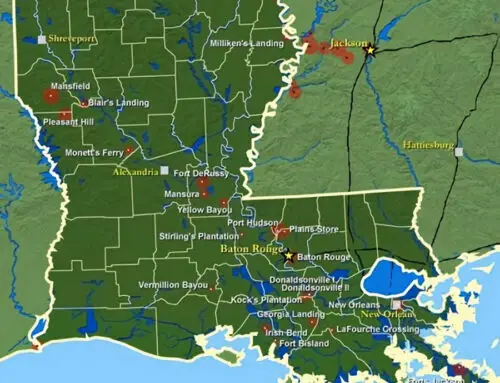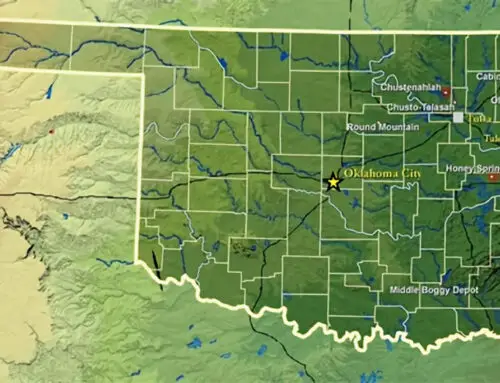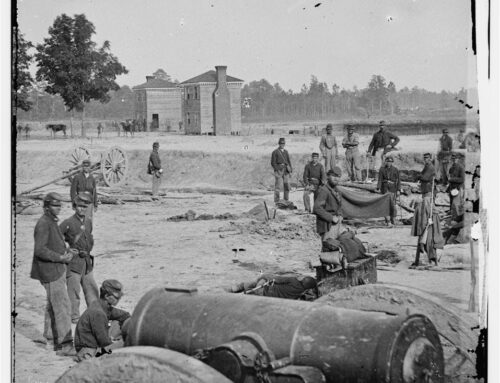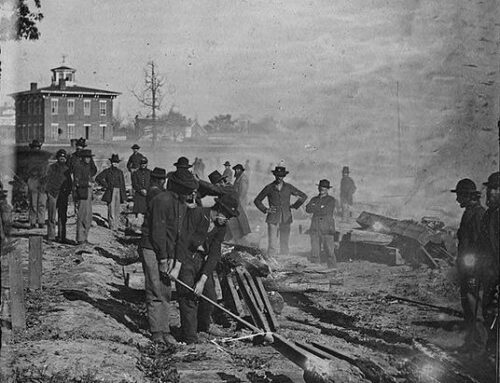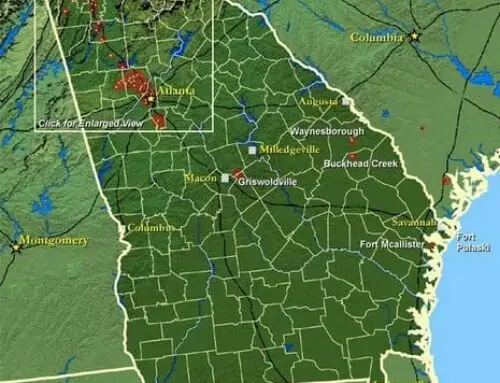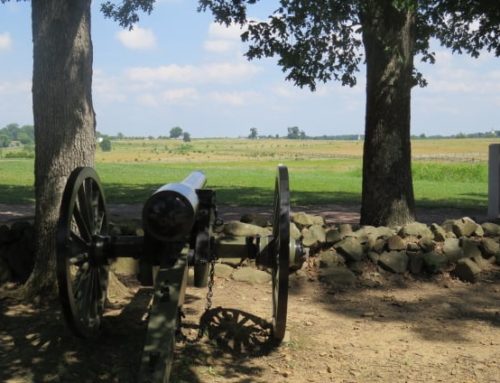Alabama was fortunate that it did not suffer through as many battles during the war as other states did. In fact no battle was fought in Alabama until 1863 almost exactly two years after the beginning of the conflict. One of the most notable battles that took place in Alabama was the battle of Mobile Bay fought in 1864.
This was a Union attack combining naval and land forces against Mobile Bay leading to a Union victory. Confederate forces were never able to win any battles in Alabama. The following is a list of all Civil War battles in Alabama. They are in the order in which they occurred during the Civil War.
Day’s Gap
Civil War Battles in Alabama
Other Names: Sand Mountain
Location: Cullman County, Alabama
Campaign: Streight’s Raid in Alabama and Georgia (1863)
Date(s): April 30, 1863
Principal Commanders: Col. Abel Streight [US]; Brig. Gen. Nathan Bedford Forrest [CS]
Forces Engaged: Men from 51st Indiana Infantry, 73rd Indiana Infantry, 3rd Ohio Infantry, 80th Illinois Infantry, and 1st Middle Tennessee Cavalry [US]; three regiments [CS]
Estimated Casualties: 88 total (US 23; CS 65)
Description: Union Col. Abel D. Streight led a provisional brigade on a raid to cut the Western & Atlantic Railroad that supplied Gen. Braxton Bragg’s Confederate army in Middle Tennessee. From Nashville, Tennessee, Streight’s command traveled to Eastport, Mississippi, and then proceeded east to Tuscumbia, Alabama, in conjunction with another Union force commanded by Brig. Gen. Grenville Dodge. On April 26, 1863, Streight’s men left Tuscumbia and marched southeast, their initial movements screened by Dodge’s troops.
On April 30, Confederate Brig. Gen. Nathan Bedford Forrest’s brigade caught up with Streight’s expedition and attacked its rearguard at Day’s Gap on Sand Mountain. The Federals repulsed this attack and continued their march to avoid further delay and envelopment. Thus began a running series of skirmishes and engagements at Crooked Creek (April 30), Hog Mountain (April 30), Blountsville (May 1), Black Creek/Gadsden (May 2), and Blount’s Plantation (May 2). Forrest finally surrounded the exhausted Union soldiers near Rome, Georgia, where he forced their surrender on May 3.
Result(s): Union victory, although the raid ultimately failed.
Athens
Civil War Battles in Alabama
Other Names: None
Location: Limestone County
Campaign: Operations in North Alabama (1864)
Date(s): January 26, 1864
Principal Commanders: Capt. Emil Adams [US]; Lt. Col. Moses W. Hannon [CS]
Forces Engaged: 9th Illinois Mounted Infantry [US]; 1st Alabama Cavalry [CS]
Estimated Casualties: 50 total (US 20; CS 30)
Description: Confederate cavalry, numbering about 600 men, attacked Athens, held by about 100 Union troops, around 4:00 am on the morning of January 26, 1864. After a two-hour battle, the Confederates retreated. Union forces, although greatly outnumbered and without fortifications, repulsed the attackers.
Result(s): Union victory (The Confederate force failed in its attempt to take Athens.)
Mobile Bay
Civil War Battles in Alabama
Other Names: Passing of Forts Morgan and Gaines
Location: Mobile County and Baldwin County
Campaign: Operations in Mobile Bay (1864)
Date(s): August 2-23, 1864
Principal Commanders: Adm. David G. Farragut and Maj. Gen. Gordon Granger [US]; Adm. Franklin Buchanan and Brig. Gen. Richard L. Page [CS]
Forces Engaged: Farragut’s Fleet (14 wooden ships and 4 monitors) and U.S. army forces near Mobile [US]; Buchanan’s Flotilla (3 gunboats and an ironclad), Fort Morgan Garrison, Fort Gaines Garrison, and Fort Powell Garrison [CS]
Estimated Casualties: 1,822 (US 322; CS 1,500)
Description: A combined Union force initiated operations to close Mobile Bay to blockade running. Some Union forces landed on Dauphin Island and laid siege to Fort Gaines. On August 5, Farragut’s Union fleet of eighteen ships entered Mobile Bay and received a devastating fire from Forts Gaines and Morgan and other points. After passing the forts, Farragut forced the Confederate naval forces, under Adm. Franklin Buchanan, to surrender, which effectively closed Mobile Bay. By August 23, Fort Morgan, the last big holdout, fell, shutting down the port. The city, however, remained uncaptured.
Results(s): Union victory
Decatur
Civil War Battles in Alabama
Other Names: None
Location: Morgan County and Limestone County
Campaign: Franklin-Nashville Campaign (1864)
Date(s): October 26-29, 1864
Principal Commanders: Brig. Gen. Robert S. Granger [US]; Gen. John B. Hood [CS]
Forces Engaged: Garrison and other troops sent there (approx. 5,000 men) [US]; Army of Tennessee [CS]
Estimated Casualties: 605 total (US 155; CS 450)
Description: As Gen. John B. Hood began the Franklin-Nashville Campaign during the fall of 1864, his Army of Tennessee demonstrated against Decatur, Alabama, October 26-29, in an attempt to cross the Tennessee River. Union forces, under the command of Brig. Gen. Robert S. Granger for most of the battle, numbered only about 5,000 men, but successfully prevented the much larger Confederate force from crossing the river.
Result(s): Union victory (Confederate forces could not cross the river.)
Spanish Fort
Civil War Battles in Alabama
Other Names: None
Location: Baldwin County
Campaign: Mobile Campaign (1865)
Date(s): March 27-April 8, 1865
Principal Commanders: Maj. Gen. E.R.S. Canby [US]; Brig. Gen. Randall L. Gibson [CS]
Forces Engaged: XVI and XIII Corps [US]; Spanish Fort Garrison [CS]
Estimated Casualties: 1,401 (US 657; CS 744)
Description: Maj. Gen. E.R.S. Canby’s XIII and XVI corps moved along the eastern shore of Mobile Bay forcing the Confederates back into their defenses. Union forces then concentrated on Spanish Fort and Fort Blakely. On March 27, 1865, Canby’s forces rendezvoused at Danley’s Ferry and immediately undertook a siege of Spanish Fort. The Union had enveloped the fort by April 1, and on April 8 captured it. Most of the Confederate forces, under the command of Brig. Gen. Randall L. Gibson, escaped and fled to Mobile, but Spanish Fort was no longer a threat.
Result(s): Union victory
Fort Blakely
Civil War Battles in Alabama
Other Names: None
Location: Baldwin County
Campaign: Mobile Campaign (1865)
Date(s): April 2-9, 1865
Principal Commanders: Maj. Gen. E.R.S. Canby [US]; Brig. Gen. St. John R. Liddell [CS]
Forces Engaged: XIII and XVI Corps [US]; Fort Blakely Garrison [CS]
Estimated Casualties: Total 4,475. April 9 only 3,529 (US 629; CS 2,900)
Description: E.R.S. Canby’s forces, the XVI and XIII corps, moved along the eastern shore of Mobile Bay, forcing the Confederates back into their defenses. Union forces then concentrated on Spanish Fort and Fort Blakely. By April 1, Union forces had enveloped Spanish Fort, thereby releasing more troops to focus on Fort Blakely. Brig. Gen. St. John R. Liddell, with about 4,000 men, held out against the much larger Union force until Spanish Fort fell on April 8, allowing Canby to concentrate 16,000 men for the attack on April 9. Sheer numbers breached the Confederate earthworks compelling the Confederates to capitulate. The siege and capture of Fort Blakely was basically the last combined-force battle of the war. African-American forces played a major role in the successful Union assault.
Result(s): Union victory (Fort Blakely surrendered.)
Selma
Civil War Battles in Alabama
Other Names: None
Location: Dallas County
Campaign: Wilson’s Raid in Alabama and Georgia (1865)
Date(s): April 2, 1865
Principal Commanders: Maj. Gen. James H. Wilson [US]; Lt. Gen. Nathan B. Forrest [CS]
Forces Engaged: Two cavalry divisions [US]; troops in city (approx. 5,000 men) [CS]
Estimated Casualties: 3,019 total (US 319; CS 2,700)
Description: Maj. Gen. James H. Wilson, commanding three divisions of Union cavalry, about 13,500 men, led his men south from Gravelly Springs, Alabama, on March 22, 1865. Opposed by Confederate Lt. Gen. Nathan B. Forrest, Wilson skillfully continued his march and eventually defeated him in a running battle at Ebenezer Church, on April 1. Continuing towards Selma, Wilson split his command into three columns. Although Selma was well-defended, the Union columns broke through the defenses at separate points forcing the Confederates to surrender the city, although many of the officers and men, including Forrest and Lt. Gen. Richard Taylor, escaped. Selma demonstrated that even Forrest, whom some had considered invincible, could not stop the unrelenting Union movements deep into the Southern Heartland.
Result(s): Union victory
Source: https://www.nps.gov/civilwar/search-battles.htm# No protection is claimed in original U.S. Government works



